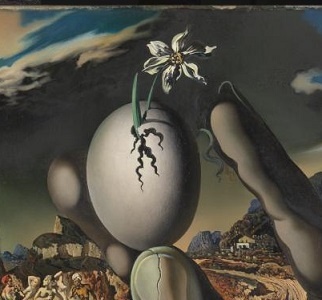The world of Surrealism owes a great deal to the imaginative capabilities of Salvador Dali. He made the movement turn into a grandiose canvas with wonderful hues in them. His works like The Persistence of Memory, Metamorphosis of Narcissus, Swans reflecting Elephants, Invention of the Monsters, etc. have made him a masterful artist and the crowning piece of Surrealism. The painting Metamorphosis of Narcissus is completed in the year 1937 and is inspired by the myth of Narcissus as in Ovid’s “Metamorphoses”.
This particular painting by Dali has many elements in it, making it a bit easier for the analysis when compared to his other works. Further, there is a clear movement of the characters in the painting giving out the attitude of Narcissus and it is perhaps a message to those who follow his lead. The painting can be divided into four parts to understand the way Dali has dealt with the myth.
- Narcissus admiring his own reflection in the pool.
- The women out of whom some are crying while some are celebrating.
- The transformation of Narcissus and the beast.
- The statue and the chessboard.
Image Source: ‘Metamorphosis of Narcissus, Salvador Dali, 1937, Photo: © Tate, London [2016]’
The first part is evident to most of the people who are aware of the myth of Narcissus. To describe in brief, Narcissus was a proud youth who declined every suitor, female and male alike. It includes Echo who disintegrates into a mere voice due to the rejection of the young man. Similarly, a young man commits suicide and asks the gods to punish Narcissus. Nemesis hears the prayers of the man and decides to punish proud Narcissus; therefore, she creates a pool that is crystal clear. When Narcissus tries to drink at the pool he falls in love with his own reflection and watches it till death. Dali clearly pictures this scene without any complex ideas and one can see Narcissus leaning to see his reflection in the pool.
The second part shows group of women with extreme emotions. While some are weeping their breasts out, some women are cheering for the death of Narcissus. The scene indicates the different women during the time of the young man who were deeply in love with him. Those who had intended for the happiness of Narcissus despite him rejecting them can be seen as crying, while those who were envious and hated him for rejecting them celebrated. It is the nature of love and the extreme thoughts one can generate that Salvador Dali has produced in his metamorphosis of Narcissus. The fact that the women are moving forward on a path indicates the decisions they have taken in their life and their chosen attitude.
The third part is the most important one as Dali pictures the metamorphosis of Narcissus in a rather unique way, but one can expect this kind of creative twist from the painter. A hand coming out of the soil holding an egg from which a plant is growing, this is typical Dali at work here. The hand has some cracks and is still even when the ants are crawling to reach the plant. This indicates that the life out of the hand is taken out and the emphasis on the death of a mortal being is magnified by the presence of a flesh eating beast. The slow yet eventual transformation process is wonderfully shown through the skinny hand, which is nothing but bones. As Dali portrayed this painting from his hallucinations, there are elements that go without explanation, like the shadows of the Narcissus and the metamorphosed figure.
The fourth part shows a statue on a chessboard. From Ovid’s Metamorphoses it is understood that Narcissus was full of pride and he treated himself as god amongst men. Hence, the portrayal of Narcissus as a statue and one can observe that on the chessboard, the statue is not perfectly present on a single place. It is moving, indicating that the chessboard is the life of Narcissus and he is about to meet slowly, which is shown in the deep mountains. The road to the mountains next to the chessboard also shows that the pride of Narcissus will eventually lead to his fall. Further, the reflection of the metamorphosis of Narcissus in the mountains also show the unending love of Echo, who sobs for his lover and still thinks of him in her place [Echo is said to be present in the mountains and answer any mournful cries from the sad lovers]. Echo is bound by an unfortunate fate when she confronts Narcissus; hence, she cannot express her love towards him. Therefore, she gets ashamed and hides herself in the mountains and slowly becomes nothing but a sound. The ingenious nature of Dali’s understanding of the emotions of Echo can be observed with the reflection of the metamorphosed figure in the mountains.
The Metamorphosis of Narcissus by Salvador Dali, though appears to be Surrealistic, has all the elements as mentioned in the book of Ovid. No other painter has ever completely given the myth in such perfection and they have only taken particular scenes. So, this is a great achievement by Dali and the masterpiece is currently situated at the Tate museum, London.
Dali's Narcissus - Download in PDF
Get the best canvas print of Dali’s great work

